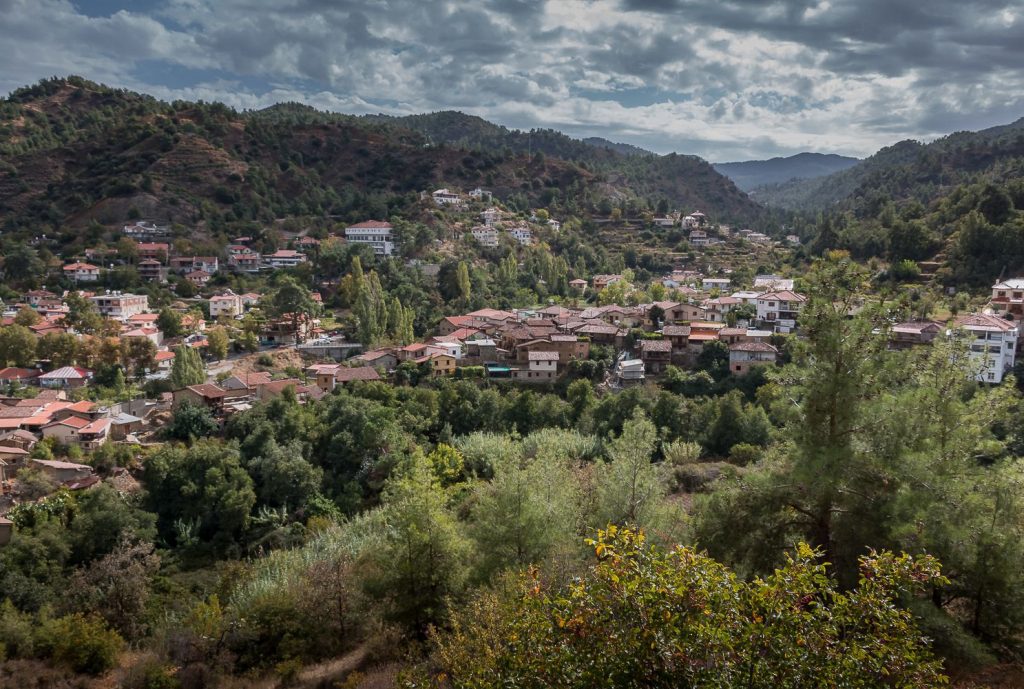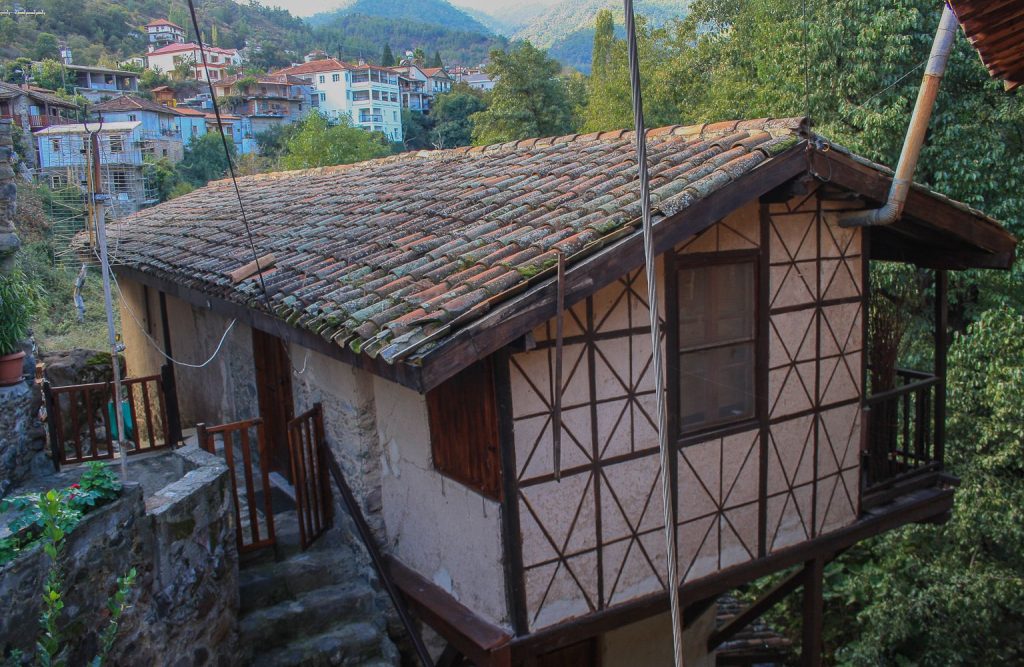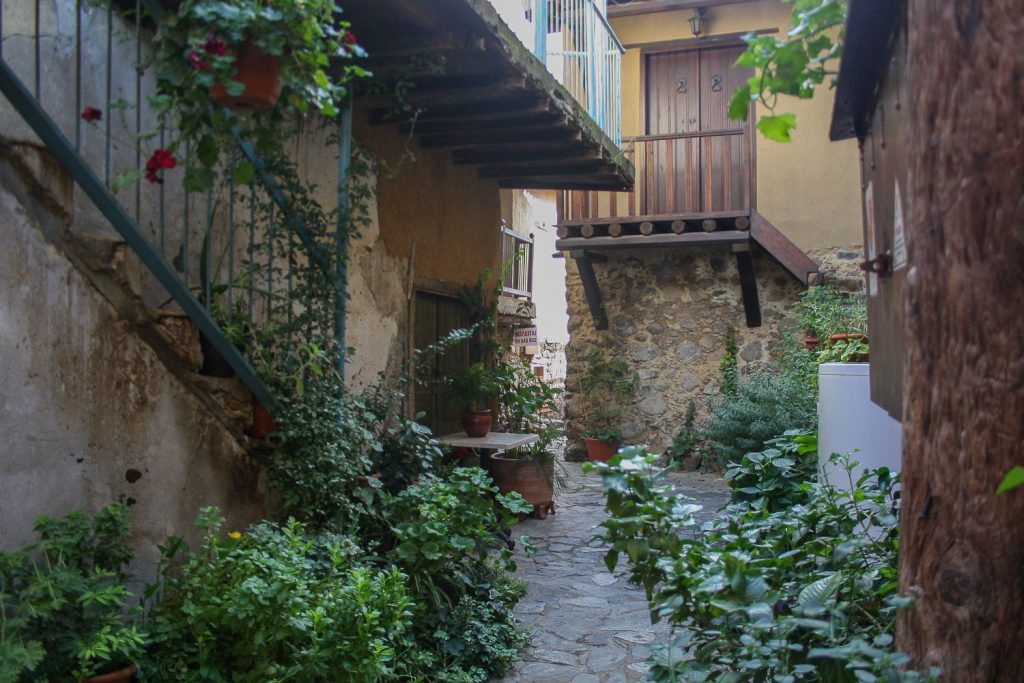Kakopetria

Kakopetria is a village of Nicosia in Cyprus and it is located 63 km southwest of the homonymous city, 48 km north of Limassol, 108 km west of Larnaca and 86 km northeast of Paphos.
A settlement built at an altitude of 670 meters on the northern side of the imposing Troodos mountain range, Kakopetria of the approximately 1,300 inhabitants, is one of the most beautiful villages – if not the most beautiful – of Cyprus. Surrounded by lush vegetation and tall planes, pines, poplars and alders, between the banks of the rivers Klarios (Karkotis) and Garilli and the fruit trees (apples, pears, plums, apricots, peaches and cherries), vegetables, vineyards (with table and wine grape varieties) and grain crops, Kakopetria is among the most famous destinations that receive thousands of visitors all year round. An emblematic landmark of winter tourism, just a few kilometers from the unique Troodos Ski Center, Kakopetria is undoubtedly the “household name” of tourism in mountainous Cyprus and one of the top tourist resorts that attract the attention of those arriving on the island of Aphrodite.
The settlement consists to the east of the valley of large modern houses and luxurious residences of affluent Cypriots and foreigners, while to the west between the two rivers dominates the beautiful and old Kakopetria, the “old village”, characterized by the traditional architecture with the narrow paved, winding alleys and adjacent stone-built two-storey restored houses with local stone from rivers and slopes, tiled roofs, wooden balconies, small courtyards and anogi (elevated ground floor). The lower floor served as a warehouse for the big jars of wine or as a shelter for the animals, while the family lived at the upper floor. It is not accidental that the old settlement is preserved and has been classified as an ancient monument of the “second table” by the Department of Antiquities of Cyprus.
Today, the community is a center of attraction for many visitors all year round and one of the most famous villages due to the healthy and cool climate, the idyllic natural landscape and the excellent tourist infrastructure it provides. Apart from the uniquely beautiful luxury hotels (such as the impressive Crystal Hotel), excellent traditional guesthouses, agrotourism accommodation and rooms for rent, Kakopetria has a kindergarten and elementary school, banks, police station, mini market and supermarkets, taverns, restaurants with local specialties, kleftiko (lamb in the oven), souvlaki or trout from the river, traditional cafes and modern cafes that are bustling with people, especially at weekends. Without losing its authenticity, this place takes full advantage of its unparalleled tradition with modern tourist hospitality, having many religious attractions and not only. Unique ancient Byzantine churches such as Agios Nicholas of Stegi, the chapel of Agios Georgios Perahoritis, the church of the Panagia (Virgin Mary), the church of the Metamorphosis of Sotira Kakopetrias (Transfiguration of Christ), the Olive Mill of Kakopetria which operates as a museum in the courtyard of the church of Savior, the Mill of Gonia Kakopetrias and the Wine Press Kakopetrias are just some of the impressive sights of the community.
There are many versions regarding the origins of the name of the village: the first one speaks of the combination of the words “kakos (evil) and petra (stone)” because of its rocky location and the fact that it used to be a challenging way up to the village. The second version refers to the Stone of the Married Couple, a large stone at the entrance of the village where it is a tradition for the newly- married couples to sit. At one point, the stone rolled over a couple, killing it, hence the “Kakopetra” (evil stone) and then Kakopetria. Today, the locals say that every couple must sit on the stone to make the marriage last and “solidify” the union, like a stone.
The third version speaks of the first settler of the village, the evil Petri. Petris was the most naughty, nervous and evil of the three sons of a lord of Marathasa. After his expulsion from his home, he resorted to this side of the mountain, establishing the village (his two brothers went to other settlements, Nikos created Oikos and Panagiotis, a good and loving son, founded Kalopanayiotis).
The village has been inhabited since the Frankish rule, and on many maps it is marked by the same name. However, according to excavations of 1938 at the site of “Ailades”, which brought to light a depositor of the ancient sanctuary of the goddess Athena, limestone small statues of herself and Hercules, bronze and iron spikes of arrows and spears, the area has been inhabited since antiquity. The findings date back to the Cypriot-Archaic and Cypriot-Classical periods and are exhibited at the Archaeological Museum of Nicosia.
The site, in the most recent past, belonged to Saint Nicholas of Stegi and later passed to the hands of the Archbishop of Cyprus, which in 1922 separated the area into 120 plots, which were distributed to the residents by lottery. It is remarkable that it was a famous area for the cultivation and production of silkworm, as well as the processing of silk until the 2nd World War, while earlier, during the Ottoman domination, there were tar kilns in the area of the forest, processing the tar.
Three of them are preserved not far from the “Pervolli site”, next to the “Pikromiloudi” at the “Atsoupokamino” site, and at the “Kaminoudi” site. Also, at the sites “Nero tou Pevkou” and “Kanoures”, there were and were operating until recently, underground chromium mines and its processing plant was located near Agios Nikolaos of Stegi.
The main church of the village, a Byzantine-style building with a dome, is dedicated to Saint Panteleimon and was built in 1994 with residents’ contributions and is celebrated on 27 July. Next to it, there is a chapel devoted to Saint Fanourios, built in 2008.
The stone church of Agios Georgios Perahoritis, 1520, is located to the north of the village and was named after “Pera Gitonia” or “Pera Chorio”, while two frescoes, Agia Anastasia or Pharmakolytra and Agia Paraskevi are still preserved inside the church.
The church of Panagia (Virgin mary) Theotokou is located at the entrance of Kakopetria and was built in 1514 with frescoes from the first half of the 16th century. The church of the Metamorphosis tou Sotira (Transfiguration of the Savior) Kakopetrias is in the middle of the “Palio Chorio”, it is a temple of 1520 and until 1994 it was the main church of the community decorated with hagiographies of the 16th and 17th centuries, as well as those of the hagiographer Simeon Auxentis, known from his frescoes at the temples of the Virgin Mary and the Archangel in Galata.
The most important religious attraction, which is one of the 10 churches of Cyprus that belong to the UNESCO World Heritage List, is St. Nicholas Stegis. The exceptional building with unique examples of Byzantine and post-Byzantine paintings covering its interior, accepts thousands of visitors each year.
The Mill of Gonia Kakopetria above the main road, on the left bank of the river Agios Nikolaos – a tributary of the river Karkotis – built in 1754, was owned by the Archdiocese and later passed into the hands of private individuals. One of the island’s most famous watermills ceased to function shortly after the end of the Second World War and was restored in 1980, opening its doors to the public as a museum space.
Kakopetria’s power plant was a pioneering electrification method by Christophoros Vassiliou, known to the locals as “Christophoros the Electrician”, who built a water-powered electric generator in 1927, writing a golden page in the history of electricity in Cyprus. In fact, it is due to this plant that the first cinema in a Cypriot village ever existed, the summer cinema “Orpheus”.
The Hero’s monument, next to the aerial bridge, is dedicated to the fallen Alekos Konstantinou and Panagiotis Tomazos who participated in the EOKA’s national liberation struggle 1955-1959 against the English. In fact, on the mountain slopes of the area, there are the hideouts of the rebels of that time, in the “Vrysi” area of the Piteres peak, at the “Ssiaka” site and at the “Yambakka” site.
For nature lovers, there are many nature attractions, with the Kakopetria forest and the local nature trails, such as the Vateri Nature Trail, passing through beautiful landscapes, the old watermills, and Stone of the Couple (Petra tou Antrogunou). To the east there is also the impressive small homonymous waterfall, while near the village there is a camping and an excursion area, near the forest station “Platania”. Within the settlement and close to the bridge is also the small but beautiful “Elena Park”.
































